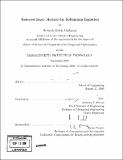Reduced basis method for Boltzmann equation
Author(s)
Garlapati, Revanth Reddy
DownloadFull printable version (3.565Mb)
Other Contributors
Massachusetts Institute of Technology. Computation for Design and Optimization Program.
Advisor
Anthony T. Patera.
Terms of use
Metadata
Show full item recordAbstract
The main aim of the project is to solve the BGK model of the Knudsen parameterized Boltzmann equation which is 1-d with respect to both space and velocity. In order to solve the Boltzmann equation, we first transform the original differential equation by replacing the dependent variable with another variable, weighted with function t(y); next we obtain a Petrov Galerkin weak form of this new transformed equation. To obtain a stable and accurate solution of this weak form, we perform a transformation of the velocity variable y, such that the semi-infinite domain is mapped into a finite domain; we choose the weighting function t(y), to balance contributions at infinity. Once we obtain an accurate and well defined finite element solution of the problem. The next step is to perform the reduced basis analysis of the equation using these accurate finite element solutions. We conclude the project by verifying that the orthonormal reduced Basis method based on the greedy algorithm converges rapidly over the chosen test space.
Description
Thesis (S.M.)--Massachusetts Institute of Technology, Computation for Design and Optimization Program, 2006. Includes bibliographical references (p. 103-106).
Date issued
2006Department
Massachusetts Institute of Technology. Computation for Design and Optimization ProgramPublisher
Massachusetts Institute of Technology
Keywords
Computation for Design and Optimization Program.